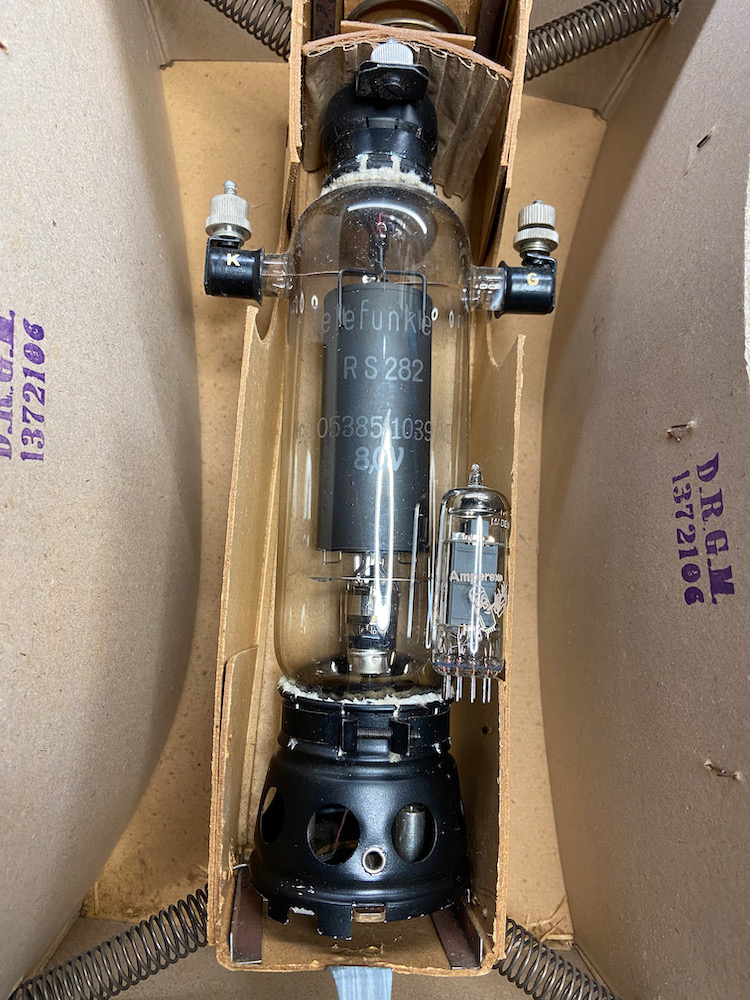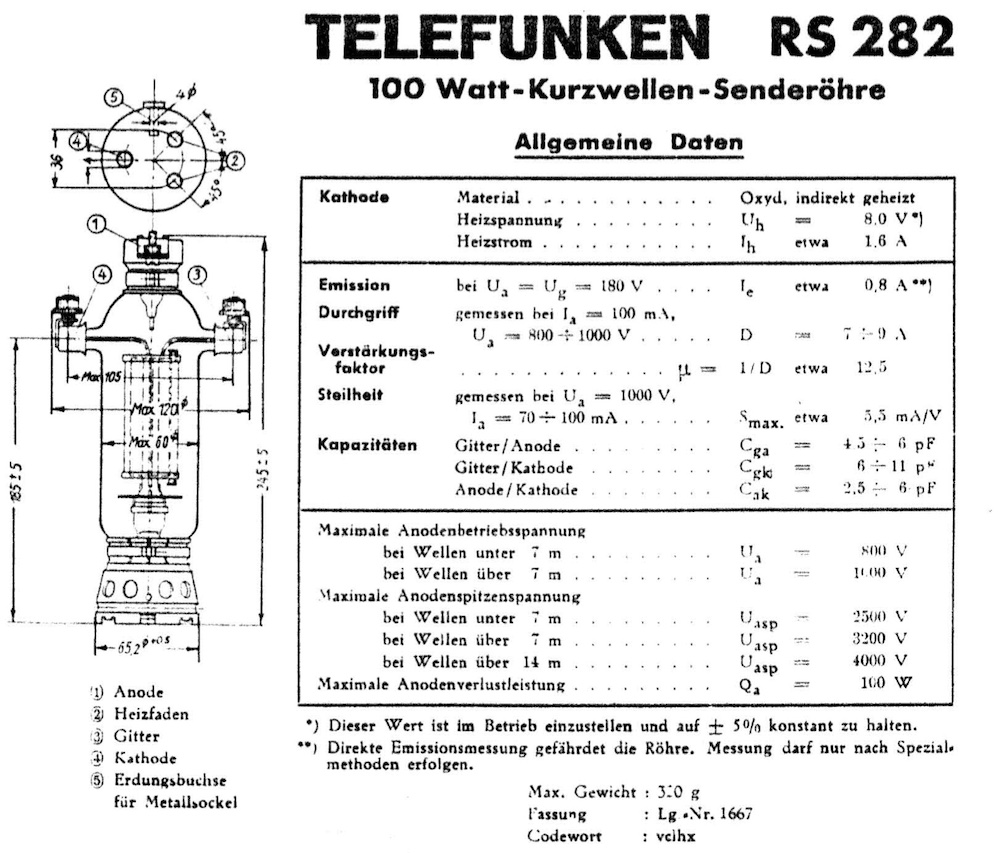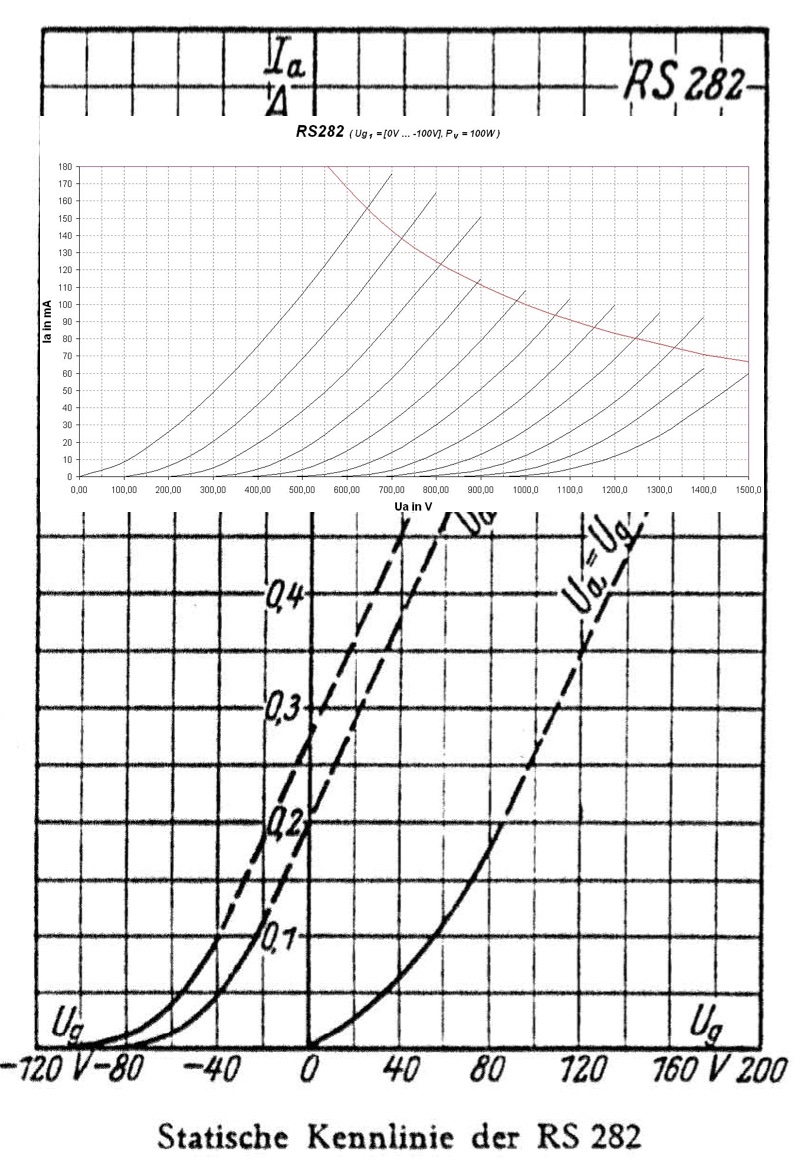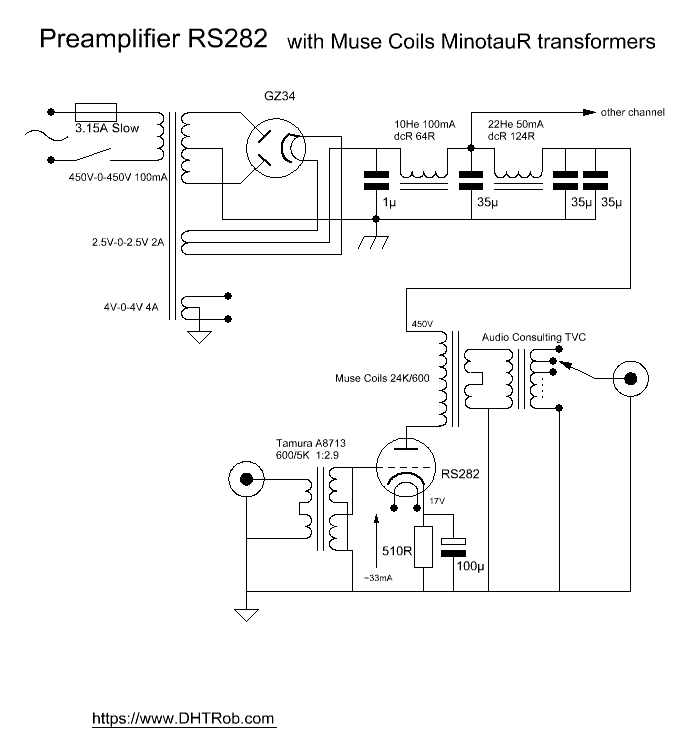A preamplifier with Muse Coils transformers and the RS282

Introduction.
So why another preamplifier, you might ask? Well, actually no other reason than curiosity.
In my current power amplifier there are six RS282 present, both as driver and parallelled in the
powerstage. Performance is phenomenal in combination with the super oversized Muse Coils transformers. Could such a combination also be used for a
preamplifier and what would be the result?. When I contacted Alexander from Muse Coils and
discussed the possibilities of a suitable line-out transformer for a RS282, things were
taking shape. At that time his MinotauR design was just an idea and still shaping up. At time of
delivery MinotauR was reality and all transformers were delivered in that design. According to
Alexander MinotauR outperforms his previous designs especially in sonics due to the use of
natural materials carefully selected during auditions.
Of course the RS282 is a tremendous overkill for a preamp, but it most certainly looks impressive.
As this is an output tube I followed my own guidance on how to
design preamplifiers using power amplifiers. This to make sure that sound is not affected by
microphonics and/or inner structure expanding sounds. These are normally not a problem when used in
the last stage of a power amplifier, but need to be dealt with in a preamplifier.
The RS282.
This is a triode developed for short-wave radio purposes, quite a beastly performer running at
max 1 KV. It has an indirectly heated cathode running at only 8 Volts at 1.6 Amps, so actually
quite an efficient triode. It measure almost 25 cm high and has most of its electrodes available
at the top of the tube as well. The topcap is the anode, two arms extruded from the glass bulb
support both grid and cathode. The base holds the connections for the heater and cathode, three
4 mm bananas can be used to make a socket as originals are almost impossible to get. Each RS282
is mounted in such a way that all electrodes perfectly align. So when parallelling multiple tubes
those could be interconnected by one strip running along the tubes for each electrode. Downside is
that high voltage is present on top of the tubes, so be careful.

The RS282 in its cradle, for size comparison a E182CC is put next to it


Operating point.
For the power amplifier I run it at 850 Volts, 60mA each tube, two in parallel, delivering easily 15
Watts of output power. As driver it runs at 480 Volts at 40mA. For preamplifier purposes I decided to
go a little more conservative and run it at 450 Volts at 33mA. With its mu of 12.5 I was particular
curious if the heater was insulated enough to be kept at AC. At this operating point transconductance
will be lower than 5 eliminating the need of stopping resistors, so longer wires running up to the
top of the tube would be no problem.
Power supply.
This is kept as simple as possible using pseudo choke input and two following chokes for channel
separation. Pseudo choke input as soundwise I prefer a small capacitor raising the voltage a little
bit. As rectifier the 5R4GY was chosen at first but a GZ34/5AR4 suits the indirectly heated RS282
better, although heats up way faster than the RS282. MKP in oil capacitors are my choice for power
supplies, motor run and not motor start. Wire used is silicon insulated tinned copper, also quite
heat resistant, and different diameter for different purposes.
Tranformers.
The most important components in any tube amplifier! Line-out transformer is specially designed
by Muse Coils, high inductance with a 6.3:1 ratio and good bandwidth. They are super oversized as
that brings out both detail and bass, also on lower listening levels. Signal transformes are for input
Tamura A8713 (step-up) and for volume control Audio Consulting, the older types as these are not susceptible to
EMI/RFI as the newer are.
Power transformers need to be designed up to specs as they need to regulate. Oversizing is not
recommended as this will worsen regulation and can cause fluctuating voltages. Also the chokes need
care. As the first one is a pseudo choke input, ripple will be huge. When this is not taken into design,
it for sure will hum mechanically. Channel separation is done by two identical chokes, little more
induction to provide for a flat DC. All transformers are finished in MinotauR design, meaning extra
care is taken in material choice, even the clamps are made out of wood and have inlays with pyrographical
lettering. Matter of personal taste as always, but I do like this design a lot!
The chassis.
These are bespoke made out of American walnut, brought to colour using Danish oil. Faceplate is copper,
2mm thick and not treated in any way. Keep clear from fingers to let it age, I like the patina a lot
which will be present after some time.. Personal taste again.
It is a two chassis design with power supply separated from signal section. They are interconnected by
one umbilical cord carrying all the voltages. This way the power supply can be placed on a separate
(audio)rack keeping resonances away from the signal section. By the way, this strategy is followed for all my
amplifiers, allowing me to use a dedicated signal (audio)rack isolated from all power supply
resonances.
The result.
Does this bring the magic as experienced from the power amplifier? It sure does!
I was more than happy to experience that AC-heating did not result in audible hum (yes, it is measurable)
and it turns out that no microphony nor inner structure sounds are audible during music playback and in between.
Nothing annoys me more than these things being audible when changing a record.
Sound is somewhat more involving though not less detailed compared to the RS55 preamplifier. Tonally
the RS282 MinotauR outperforms any preamplifier built by me so far. And no, this is not because of
limited bandwidth as this is as promised by the supplied datasheet (see photos): no saturation in lower
frequencies and touching 60Khz with just a minimal resonant (meaning that the line-out transformer is the
limiting factor, not the input transformer nor the TVC).
And yes, also a feast to listen to at lower levels, no need to pump up the volume for bass!
The diagram.
Here it is. Simple and straight forward. Costly however because of the transformers.. but take into
account that exactly these will determine the sound.

Yes, it turns phase 180 degrees. You can correct that at input transformer though.. or just reverse
speaker connections.
Alexanders' words on the preamplifier and whole set-up.
In the week before ETF.22 I invited Alexander at my house for a small gathering to get to know him
better and to have a listen as well to his transformers being put at work. He suggested to post his
his nice words in this article as his input. So here it is:
When Rob contacted me and requested 90H of primary inductance, I thought I had heard everything. But at that time I was already convinced that the weight of the transformer was interconnected to its tone. Basically, the higher the transformer mass, the more we get a thicker and controlled tone, including a feeling of darker background and a richer holography soundstage. By doing a few excel sheet simulations I found out the huge core and weight this thing will require to achieve the 90H Lp. Basically, it's a core big enough to create a GM70 SE output transformer.
Despite my sloppy deadline discipline, Rob managed to compensate for the lost time by building the preamp in a hurry just before the ETF and thanks to his invitation, we managed to both listen and discuss it.
Honestly, Rob's system is one of those where the listener just shuts ups and listens. Or simply said, he created the kind of sound I thought was extremely hard or impossible to find, I believe, due to the inflated popularity of the typical "high-end, squeaky, sketchy, grab-your-attention-wow-effect sound".
Rob's system is, firstly, what I find the most important aspect of my beliefs in high-end audio - humane and honest type of sound. It's warm where it has to be, it's sharp and punchy when requested to. No cow "moo", no witch shouting, no bells in your face, no bass ka-boom, just music. The soundstage holography materializes into his living room within realism of endless layers, grabs you in and immerses you into a realism of tone, dimensions, decay and control.
I think Rob created a preamp with the heart and soul of a beast SE amplifier. I felt very proud of seeing my transformers mounted on his beautiful craft. But the biggest pleasure came from the resulting sound. It felt like a surgery transplant of music, from my work into his home. And knowing all these years of research, it took me to develop the tone. It was a great enjoyment hearing a very familiar pattern of sounds at Rob's home!
To complete this story I placed a picture of my current system here.
